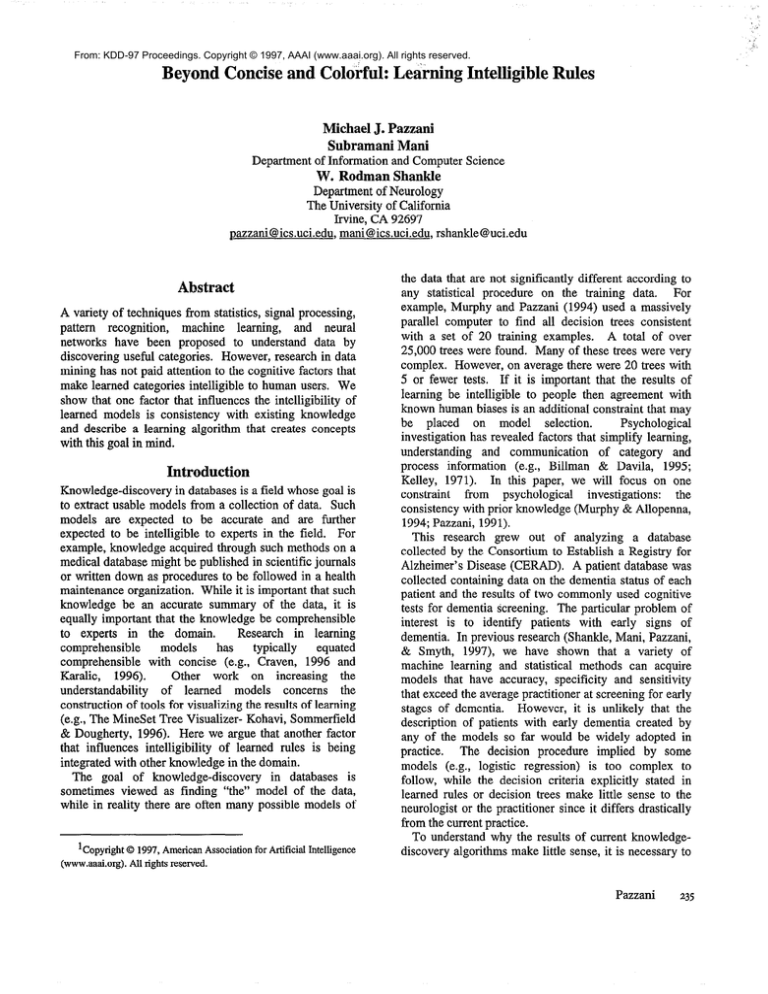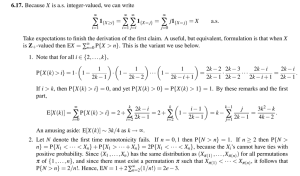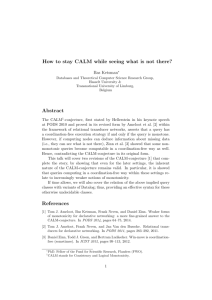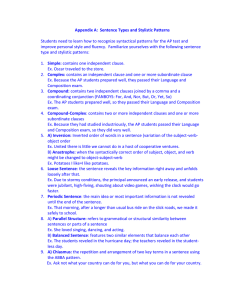
From: KDD-97 Proceedings. Copyright © 1997, AAAI (www.aaai.org). All rights reserved.
Beyond Concise and Coldkful: Lehming Intelligible Rules
Michael J. Pazzani
Subramani Mani
Departmentof Information and ComputerScience
W. Rodman Shankle
Departmentof Neurology
The University of California
Irvine, CA 92697
pazzani@ics.uci.edu,mani@ics.uci.edu,rshankle@uci.edu
Abstract
A variety of techniquesfrom statistics, signal processing,
pattern recognition, machine learning, and neural
networks have been proposed to understand data by
discovering useful categories. However, researchin data
mining has not paid attention to the cognitive factors that
make learned categoriesintelligible to human users. We
ohnwr
cu.” w
+hn+
UllaL
_,.a
“II-d
Cnnte...
lcLlrl.“l
the+
UlaL
;nfl.,nmnao
I,,IIUcII,~U,J
thn
LllU
;ntczll;~.;h:l;+.r
IIILtAII~,“IIICJ
nf
“I
learned models is consistency with existing knowledge
and describe a learning algorithm that creates concepts
with this goal in mind.
Introduction
Knowledge-discoveryin databasesis a field whosegoal is
to extract usable models from a collection of data. Such
models are expected to be accurate and are further
expected to be intelligible to experts in the field. For
example,knowledge acquired through such methodson a
medical databasemight be publishedin scientific journals
or written down as proceduresto be followed in a health
maintenanceorganization. While it is important that such
knowledge be an accurate summary of the data, it is
equally important that the knowledge be comprehensible
to experts in the domain. Research in learning
equated
comprehensible models has typically
comprehensible with concise (e.g., Craven, 1996 and
Other work on increasing the
Karalic, 1996).
understandability of learned models concerns the
constructionof tools for visualizing the results of learning
(e.g., The MineSet Tree Visualizer- Kohavi, Sommerfield
& Dougherty, 1996). Here we argue that another factor
that influences intelligibility of learned rules is being
integratedwith other knowledgein the domain.
The goal of knowledge-discovery in databases is
sometimes viewed as finding “the” model of the data,
while in reality there are often many possible models of
kopyright 0 1997, American Association for Artificial Intelligence
(www.aaai.org). All rights reserved.
the data that are not significantly different according to
any statistical procedure on the training data. For
example, Murphy and Pazzani (1994) used a massively
parallel computer to find all decision trees consistent
with a set of 20 training examples. A total of over
25,000 trees were found. Many of these trees were very
complex. However, on averagethere were 20 trees with
5 or fewer tests. If it is important that the results of
learning be intelligible to people then agreementwith
known human biasesis an additional constraint that may
Psychological
be placed on model selection.
investigation has revealed factors that simplify learning,
understanding and communication of category and
process information (e.g., Billman & Davila, 1995;
Kelley, 1971). In this paper, we will focus on one
constraint from psychological investigations: the
consistencywith prior knowledge(Murphy & Allopenna,
1994;Pazzani,1991).
This research grew out of analyzing a database
collected by the Consortium to Establish a Registry for
Alzheimer’s Disease(CERAD). A patient databasewas
collected containing data on the dementia status of each
patient and the results of two commonly used cognitive
tests for dementiascreening. The particular problem of
interest is to identify patients with early signs of
dementia. In previous research(Shankle,Mani, Pazzani,
& Smyth, 1997), we have shown that a variety of
machine learning and statistical methods can acquire
models that have accuracy, specificity and sensitivity
that exceedthe averagepractitioner at screeningfor early
stages of dementia. However, it is unlikely that the
description of patients with early dementia created by
any of the models so far would be widely adopted in
practice. The decision procedure implied by some
models (e.g., logistic regression) is too complex to
follow, while the decision criteria explicitly stated in
learned rules or decision trees make little sense to the
neurologist or the practitioner since it differs drastically
from the currentpractice.
To understandwhy the results of current knowledgediscovery algorithms make little sense,it is necessaryto
Pazzani
235
describe how cognitive tests are currently used for
screening. In each test, the patient answersquestions that
assess orientation for time and piace, registration,
attention, short-term recall, language skills, and drawing
ability. For example, the patient is first asked to
remember a name and address (“John Brown, 42 Market
Street, Chicago”) and later asked to recall these items.
The patient receives a score for each item in the test. For
example, the number of times that the test giver repeats
the name and addressbefore the patient is able to repeat it
is recorded. An overall score is given to each patient by
summing the score on each question. A threshold on the
total score is used in practice for screeningfor dementia.
The score on each question of the test and the patient’s
age, sex, and years of education were used in our earlier
work to predict whether a patient was “normal” or
“mildly impaired” by learning algorithms. We showed
that such methods would be more effective than a simple
threshold on the aggregate score because some questions
seemedmore important than others. All of the algorithms
were more accurate than the simple threshold and none of
the methods were substantially more accurate than the
others. In such a case, one might prefer to make decisions
based upon rules or trees since such representations are
easy to follow. However, neither the trees produced by
C4.5 (Quinlan, 1993) nor the rules produced by rule
learners such as C4.5rules or FOCL (Pazzani & Kibler,
1992) produced rules that would be acceptablein practice.
In particular, some items that should be viewed as signs
of being impaired are used as signs of being normal and
vice versa. Table 1 shows an example of one such rule
that was produced by FOCL.
In the remainder of this paper, we first discuss rule
learning algorithms using FOCL as an example. We
describe an extension to FOCL to prevent it from learning
rules that violate the expectations of a domain expert and
show that the extension does not hurt the diagnostic value
of the learned concepts. We present evidence that one
neurologist prefers rules without these violations.
Background:
Rule Learners
FOCL is derived from Quinlan’s (1991) FOIL system.
FOIL is designed to learn a set of clauses that distinguish
positive examples of a concept from negative examples.
Each clause consists of a conjunction of tests. For
.I]^-..:.. il^ &..^A
-Z-L& GIIGLX
..L--1. L--^
^_-^--I- 11,
:-A-..
.I..-..-&.:- uu11klJ11
r;asu11pt;,
UK UG,,,G‘,lIil
Ltal
llllglll
1u SGG
whether the patient’s age is less than a certain value or
whether the age is greater than a certain value.
FOCL follows the same procedure as FOIL to learn a
set of clauses. However, it learns a set of clausesfor each
class (such as normal and impaired) enabling it to also
deal with problems that have more than two classes. The
clause learning algorithm is run once for each class,
treating the examples of that’class as positive examples
236
KDD-97
Table 1: Rule with questionabletests underlined.
IF the vears
natient -is >_ -5
, ~~~- of
-- education of the rl--d_-_
AND the patient does not know the date
AND the uatient does not know the name of a
nearbv street
THEN The patient is NORMAL
OTHERWISE IF the number of repetitions
before correctly reciting the addressis > 2
AND the age of the natient is > 86
THEN The patient is NORMAL
AND the mistakes recalling the addressis < 2
THEN The patient is NORMAL
OTHERWISE The patient is IMPAIRED
and the examples of all other classes as negat: le
examples. This results in a set of clausesfor each class.
FOCL has an optimization procedure that selects an
ordered subset of the original clauses to convert a set of
clauses for each class into a single decision list. The
algorithm initializes the decision list to a default clause
that predicts the most frequent class. Next, it tries to
improve upon the current decision list with an operator
that replaces the default rule with a learned clause and a
new default clause. The impact is calculated of adding
each remaining clause to the end of the current decision
list and assigning the examples that match no clause to
the most frequent class of the unmatched examples. The
changethat yields the highest impact in accuracy is made
and the process is repeated until no change results in an
improvement. Typically, only a few clauses are selected
by this process resulting in a relatively short decision
procedure. Using the same examples to learn the initial
set of clauses and to create the ordered decision list can
result in overfitting becausethe learned rules rarely make
errors on the learning data. Therefore, we divide the
training data into a learning set consisting of 2/3 of the
training data for learning clauses and an ordering set
consisting of the remaining l/3 of the training data for
creating the decision list. One further detail is neededto
understand how FOCL arrives at a decision list using
rule optimization. When adding clauses to the decision
list, FOCL also has the option to choose a prefix of a
learned clause. That is, if a clause such as X&Y&Z was
learned, FOCL considers using X or X&Y in addition to
X&Y&Z as a clause in the decision list.
Monotonicity
Constraints
Some clauses in the learned category descriptions
violate the intent of the tests used for screening. In
particular, getting some questions right is used as
evidence that one is impaired and getting some questions
wrong is used as evidence that one is not impaired. A
relatively simple change to FOCL eliminates such tests
from consideration.
For variables with numeric
relationships, the user declares whether the variable has a
known monotonic relationship with each class. A
monotonic relationship is one in which increasing the
value of the variable always increases or decreasesthe
likelihood category membership. When considering tests
to add to a clause, the tests that violate these relationships
are removed from consideration. For example, when
learning a description of the normal patients, FOCL with
monotonicity constraints only checks to see if the number
of errors recalling the addressis less than some number.
When learning clauses describing the impaired category,
it only tests to see if this variable is above some threshold.
These constraints on tests may also be used on Boolean
and nominal variables. In this case, the user specifies
which values are possibly indicative of membership in a
class. For example, a value of true for the variable
“knows the date” may be used as a sign for normal, while
the value false may be used as a sign for impaired. Table
2 shows an example of a decision list learned with
constraints provided by the neurologist working on this
.vm.;P,x.t
p&“puL.
If we assumethat the constraints are correct, then there
are two factors that contribute to a test that violates these
constraints being used in a rule. First, while the test
appearedbest according to an information-based selection
procedure, this procedure detected a “spurious
correlation” in the data due to sampling biases or noise.
Second, there are often several tests that are equally
informative or statistically indistinguishable. Under these
circumstances,a decision procedure could be found that is
both accurate and comprehensible to an expert by
eliminating from consideration tests that violate
monotonicity constraints.
To test whether a neurologist preferred rules that did
not violate constraints, we generated 16 decision lists
from constrained and unconstrained FOCL. Each rule
was printed on a separatesheet of paper and presentedin
a random order to a neurologist not involved in this
project. We asked the neurologist to rate on a scale of O10 “How willing would you be to follow the decision rule
in screening for cognitively impaired patients?” We
hypothesized that the neurologists would be more willing
to use rules that were generated by FOCL when it used
monotonicity constraints. The average score of rules
generatedby FOCL without the monotonicity constraints
was 0.25, while the average score of rules generatedwith
t'he monotonicity constraints was significantiy higher at
2.38 t(l.5) = 5.09, p < .OOl.
Violations
of the monotonicity
constraints
So far, we have assumedthat the monotonicity constraints
are correct and the learning system does not allow
Table 2. A rule learned with monotonicity constraints.
IF the years of education of the patient is > 5
AND the mistakesrecalling the addressis c 2
THEN The patient is NORMAL
OTHERWISE
IF the years of education of the patient is > 11
AND the errors made saying the months backward is < 2
THEN The patient is NORMAL
OTHERWISE
IF the years of education of the patient is > 17
THEN The patient is NORMAL
OTHERWISE The natient is IMPAIRED
violations of the constraints. Ideally, we would not allow
rules that violate the constraints unless violating them
results in more accurate rules. Here we describe an
extensionto FOCL that implements this idea.
The rule optimization algorithm selects from a pool of
clauses that contains clauses learned on the training set
with constraints and clauses learned from the same
training data without constraints. The rule optimization
procedure is changed to prefer clauses learned with
constraints when the addition of two clauses results in
the same increase in accuracy. Initial experimentation
with this algorithm revealed that often all of the clauses
in the optimized decision list came from one source or
the other. This occurs because each set of clauses
representsan alternative way of partitioning the training
examples into disjunctive sets and clauses from these
two different sources usually cannot be recombined to
cover the training data. To mitigate this problem, we
have further extended FOCL to learn alternative rules
from the sametraining data. We use stochastic search in
FOCL to achieve this. Rather then selecting the most
informative condition to add to each rule, FOCL selects
among the k (3) most informative tests with probability
proportional to the informativeness. By repeating the
process of learning a set of rules from the training data,
several alternative partitions of the data are formed. In
the experiment reported below, 5 rule sets are learned
without monotonicity constraints and 5 rule sets are
learned with monotonicity constraints. These are all
enteredinto the pool of rules for rule optimization.
Table 3 shows the accuracy of C4.5, C4.5rules and
FOCL under various conditions with optimized rules on
the
UI”
fWR
VYIYXYAn
rlata
. . ..a-.
The
ill”
cac-,.,~rcs~xr ia
omaronwl
LWVUAU”~
*La U.“AU6VU
AIIPV
“.VI
Gn
4”
trials of dividing the data into a training set of size 210
and a test set of size 105. The test set does not contain
any examples from the training set. The four conditions
of FOCL reported are 1) no monotonicity constraints, 2)
monotonicity constraints, 3) stochastic search and rule
optimization selecting from 10 rule sets learned without
Pazzani
237
monotonicity constraints and 4) stochastic searchand rule
optimization selecting from 5 rule sets learned without
monotonicity constraints and 5 rule sets learned with
monotonicity constraints.
Table 3. Accuracy at identifying impaired patients.
Algorithm
c4.5
1 Accuracy
I 86.7
References
I
The first noteworthy result is that FOCL is significantly
more accurate than the C4.5 and C4.5 rules at the .Ol
level using two-tailed t-tests. Second, there is not a
substantial or significant difference in accuracy in using
the constraints. FOCL is 90.7% accurate when using
monotonicity constraint and 90.6% accurate when
unconstrained. On average,a decision list formed without
constraints contains a total of 4.65 tests and 2.13
violations of the monotonicity constraints. With the
constraints, an average of 4.30 tests are used in a decision
list, none of which violate the constraints.
The results show that there is an added benefit in
selecting from combined multiple sets of rules learned
with and without monotonicity constraints. Optimized
rules from this source are significantly more accurate (at
the .Ol level using a paired two-tailed t-test) than
optimized rules learned in the same manner without
monotonicity constraints. Furthermore, the average
number of monotonicity constraint violations is
significantly reduced (from 2.06 to 0.75).
Conclusions
We have argued that to be truly useful, the knowledge
discovered in databases must both be accurate and
comprehensible. We have further argued that one factor
that influences the comprehensibility of learned
knowledge is the use of conditions as evidence for
belonging to some category when prior knowledge
indicates that these conditions are evidence that an
example does not belong to that category. We have
created an enhancement to one algorithm that prevents
these conditions from being added to learned models.
Finally, we have presented preliminary evidence that
experts prefer rules that do not contain violations of prior
knowledge.
Acknowledgments
The authors gratefully acknowledge CERAD for
collecting and disseminating the database used in this
238
KDD-97
study. This research was funded in part by the
Alzheimer’s Association Pilot ResearchGrant, PRG-95161 and the National Science Foundation grant IRI9310413.
Billman, D. and Davila, D. 1995. Consistency is the
hobgoblin of human minds: People care but concept
learning models do not.
In Program of the
Seventeenth Annual Conference of the Cognitive
ScienceSociety. Erlbaum: Hillsdale, NJ.
Clark, P. and Niblett, T. 1989. The CN2 Induction
Algorithm Machine Learning, 3 261-284.
Craven, M. W. 1996. Extracting Comprehensible
Models from Trained Neural Networks. Ph.D. thesis,
Department of Computer Sciences, University of
Wisconsin-Madison. (Also appears as UW Technical
Report CS-TR-96-1326)
Karalic, A. 1996. Producing More Comprehensible
Models While Retaining Their Performance,
Information, Statistics and Induction in Science,
Melbourne, Australia.
Kelley, H. 1971. Causal schemata and the attribution
process. In E. Jones, D. Kanouse, H. Kelley, N.
Nisbett, S. Valins, and B. Weiner eds. Attribution:
Perceiving the causes of behavior (pp 151-174).
Morristown, NJ: General Learning Press.
Kohavi, R., Sommerfield, D., and Dougherty .I., 1995.
Data Mining using MLC++, a Machine Learning
Library in C++. IEEE Tools With Artificial
Intelligence.
Murphy, G.L. and Allopenna, P.D. 1994. The locus of
knowledge effects in concept learning. Journal of
Experimental Psychology: Learning, Memory, and
Cognition, 19, 203-222.
Murphy, P. and Pazzani, M. 1994. Exploring the
Decision Forest: An Empirical Investigation of
Occam’s Razor in Decision Tree Induction. Journal of
Artificial Intelligence Research 1 pp. 257-275.
Pazzani, M. 1991. The influence of prior knowledge on
concept acquisition: Experimental and computational
results. Journal of Experimental Psychology:
Learning, Memory & Cognition, 17, 3, 416-32.
Pazzani, M. and Kibler, D. 1992. The utility of
knowledge in inductive learning. (9):57-94.
Quinlan, J.R. 1990. Learning logical definitions from
relations. Machine Learning, 5, 239-266.
Quinlan, J. 1993. C4.5: Programs for Machine Learning.
Morgan Kaufmann, Los Altos, California
Shankle, W.R., Mani, S., Pazzani, M. and Smyth, P.
1997. Detecting very early stages of dementia from
normal aging with machine learning methods. The
Proceedings of the 6th Conference on Artificial
Intelligence in Medicine Europe.







